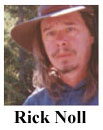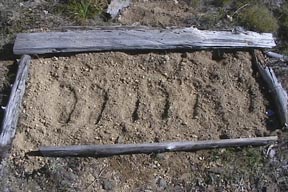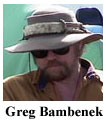|
Sunday, September 17
Things stayed fairly quiet and activity was at a minimum. The weather was excellent. The sun was out,
and daytime temperatures peaked near 75 degrees.
Noll and Fish
finished setting up the basics for camp, which included constructing a latrine
and setting up a spare tent for supplies. Fish spent most of the day wandering
about the immediate area, and familiarizing himself with the local flora and fauna.
Noll stayed at camp most of the day, so as to help establish a human presence there.
Noll did leave briefly to locate Randles, whom he found at Lone Butte Snopark.
 Noll also created what is known as a Track Garden at camp. He raked up a small patch
of dirt, measuring 2 feet by 4 feet, and bordered it with sticks. The purpose of this
Track Garden was to help in determining how prints and tracks age in the area, based on
soil composition, time, and weather conditions. Each day, a different member of the expedition
would leave a bare footprint in the garden. The print would be documented, including which researcher
left the imprint and on what day. Over the course of the week, the differences between prints left the
first day and prints left recently became quite evident. This garden was an excellent tool of reference when
trying to determine the age of other tracks found in the area.
Noll also created what is known as a Track Garden at camp. He raked up a small patch
of dirt, measuring 2 feet by 4 feet, and bordered it with sticks. The purpose of this
Track Garden was to help in determining how prints and tracks age in the area, based on
soil composition, time, and weather conditions. Each day, a different member of the expedition
would leave a bare footprint in the garden. The print would be documented, including which researcher
left the imprint and on what day. Over the course of the week, the differences between prints left the
first day and prints left recently became quite evident. This garden was an excellent tool of reference when
trying to determine the age of other tracks found in the area.
The survey of the immediate area did turn up sign from a variety of animals, including
black bear, coyote, elk, deer, and cougar. Fish also identified several species of
birds in the area, by both sight and calls. Among them were Gray Jay, Great Horned Owl,
Northern Pigmy Owl, Chestnut-backed Chickadee, Audubon Warbler, Red-breasted Nuthatch,
Golden-crowned Kinglet, Raven, Dark-eyed Junco, White-crowned Sparrow, Northern Flicker,
Pileated Woodpecker, and Hairy Woodpecker.
Although only 3 researchers were present at the camp, and they were keeping their activities to a minimum,
they were achieving a very important objective. This was the process of slowly acclimating
the local animals to a benign human presence in the area. This 72-hour period was vital in helping
these animals get used to us, and feel more at ease about remaining in close to our position.

Track Garden. Photo by LeRoy Fish
Matt Moneymaker and Dr. Greg Bambenek arrived at Portland International Airport
early in the afternoon. They were met there by Thom Powell, who escorted them
to a relative of Thom's house where Moneymaker and Bambenek would be
staying until they left for basecamp. Lemley and Lee met the group there at
2 PM. Powell and Moneymaker were out retrieving a loudspeaker system that had been
shipped up to Portland from Northern California by John Frietas for the expedition, but
they soon returned. The group discussed final preparations and scoured over maps of the target
location.
 Vaughn Hughes arrived shortly thereafter, bringing some newly recorded copies of a suspected sasquatch
scream from California. Hughes had taken the original recording, which was made in August of 2000, and digitally
cleaned it, removing the background noise. The resulting recording was then burned onto CD for broadcasting during the
expedition. The meeting ended around 5 PM.
Vaughn Hughes arrived shortly thereafter, bringing some newly recorded copies of a suspected sasquatch
scream from California. Hughes had taken the original recording, which was made in August of 2000, and digitally
cleaned it, removing the background noise. The resulting recording was then burned onto CD for broadcasting during the
expedition. The meeting ended around 5 PM.
Expedition
Report - Day Three
Expedition
Report - Front Page
|





















